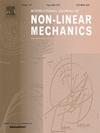Differential growth and shape formation of a flower-shaped structure
IF 2.8
3区 工程技术
Q2 MECHANICS
International Journal of Non-Linear Mechanics
Pub Date : 2024-09-27
DOI:10.1016/j.ijnonlinmec.2024.104918
引用次数: 0
Abstract
Morphogenesis, which is a complex interplay of biological, chemical, and physical processes, facilitates differential growth in various biological systems, particularly in plant organs, such as petals and leaves. Although recent studies have increasingly delved into the mechanical aspects of these biological structures, there remains a lack of a comprehensive quantitative understanding of shape formation induced by differential growth in plant organs. Thus, this study addressed this gap by employing a multifaceted approach encompassing theoretical analyses and comprehensive finite element analysis of the effect of differential growth on the shape of a cylinder into a flower shape. Based on the derivation of the strain energy expressions for the axisymmetric and asymmetric configurations, the shape function of the growing flower-like structures were calculated through mathematical optimization. The findings of this study shed light on the influence of the growth function, geometric characteristics, and material properties. As the wave number increased, the final configuration tended to have smaller waves, whereas a longer cylinder buckled more easily and the thickness had a minimal effect. This study offers insights that can pave the way for innovative geometrical designs, thereby providing inspiration for applications on both micro-and macroscales, such as in the realms of self-assembly of soft robotics and flexible electronics.
花形结构的差异生长和形状形成
形态发生是生物、化学和物理过程的复杂相互作用,它促进了各种生物系统的差异生长,尤其是在花瓣和叶片等植物器官中。尽管最近的研究越来越深入地探讨了这些生物结构的机械方面,但对植物器官差异生长所诱导的形状形成仍然缺乏全面的定量了解。因此,本研究针对这一空白,采用了包括理论分析和综合有限元分析在内的多层面方法,研究差异生长对圆柱体形状转化为花朵形状的影响。在推导出轴对称和非对称构型的应变能表达式的基础上,通过数学优化计算了生长花状结构的形状函数。研究结果阐明了生长函数、几何特征和材料特性的影响。随着波数的增加,最终结构往往具有较小的波,而较长的圆柱体则更容易弯曲,厚度的影响微乎其微。这项研究提出的见解可以为创新几何设计铺平道路,从而为微观和宏观领域的应用提供灵感,例如软机器人和柔性电子器件的自组装领域。
本文章由计算机程序翻译,如有差异,请以英文原文为准。
求助全文
约1分钟内获得全文
求助全文
来源期刊
CiteScore
5.50
自引率
9.40%
发文量
192
审稿时长
67 days
期刊介绍:
The International Journal of Non-Linear Mechanics provides a specific medium for dissemination of high-quality research results in the various areas of theoretical, applied, and experimental mechanics of solids, fluids, structures, and systems where the phenomena are inherently non-linear.
The journal brings together original results in non-linear problems in elasticity, plasticity, dynamics, vibrations, wave-propagation, rheology, fluid-structure interaction systems, stability, biomechanics, micro- and nano-structures, materials, metamaterials, and in other diverse areas.
Papers may be analytical, computational or experimental in nature. Treatments of non-linear differential equations wherein solutions and properties of solutions are emphasized but physical aspects are not adequately relevant, will not be considered for possible publication. Both deterministic and stochastic approaches are fostered. Contributions pertaining to both established and emerging fields are encouraged.

 求助内容:
求助内容: 应助结果提醒方式:
应助结果提醒方式:


